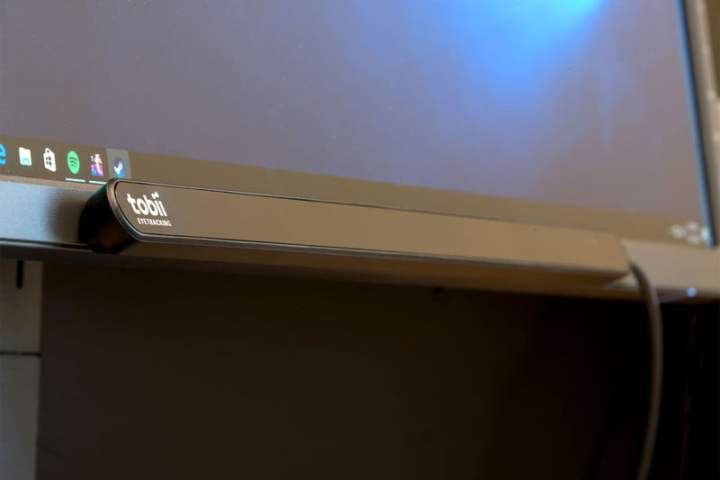
Beta support for eye control was introduced to Windows Insiders via preview build 16257. For now, support is limited to just one specific piece of eye tracking hardware, the Tobii Eye Tracker 4C, but that will change in the near future as support for more hardware options is added. For example, support is coming soon for the Tobii Dynavox PCEye Mini, PCEyePlus, EyeMobile Plus, and i-Series.
A number of key capabilities will be supported by Windows 10 Eye Control. These capabilities are focused on accessing applications, entering information, and communicating, and they add on to the eye tracking features that Tobii already brings to Windows 10.
Eye Control Launchpad
The basic Windows 10 Eye Control user interface (UI) element is the launchpad, which allows users to simply look at icons to access the mouse, keyboard, and text-to-speech features as well as to move the launchpad to the top or bottom of the display. Interacting with the Eye Control UI is simple but requires some practice: just look at the screen and focus, or “dwell” as Microsoft calls it, on a button or other element until it engages. The system provides feedback throughout that lets you know what you’re doing.

The Eye Control mouse
Selecting the Eye Control mouse from the launchpad lets a user place the mouse cursor at a specific point on the screen and then make fine adjustments to its location. Then, users can emulate mouse actions including left-click, double left-click, and right-click, as well as cancel a particular mouse session.

Eye Control keyboard
Next up is the Eye Control keyboard, which lets a user enter information just by dwelling on individual keys. Letters, numbers, symbols, and function keys are all accessible, although for now, support is limited to the EN-US keyboard layout.

Eye Control shape-writing
The same shape-writing that’s supported via touch and mouse is also supported in Windows 10 Eye Control. A user can simply dwell on the first and last characters of a word and glancing at different letters to generate words. The system provides a hint of the predicted word, along with alternative predictions that can be selected if the initial hint was incorrect.

Eye Control text-to-speech
Finally, a user can use the text-to-speech feature to type words using either the standard keyboard or shape-writing, and the system will speak the resulting words and sentences aloud. In addition, phrases are available that can be immediately spoken aloud, and the displayed choices can be customized. The text-to-speech feature uses the default voices, which can be adjusted in Settings > Time & Language > Speech > Text-to-speech.

Setting up Windows 10 Eye Control
Getting eye tracking to work in build 16257 is fairly straightforward. First, install the Tobii Eye Tracker 4C using Tobii Core eye tracking hot fix release 2.10.11.6458. Follow all of the usual Tobii instructions to make sure your eye tracker is located properly. Then, calibrate the hardware and create a profile — the installation routine will automatically run you through the process.
Next, go to Settings > Update & Security and hit the “Check for updates” button. You should receive a new Tobii Eye Tracker HIDClass Driver, and it should automatically install.

Once that’s completed, simply go to Settings > Ease of Access > Other Options and toggle the switch under “Eye control (beta)” to On. You’ll see the Eye Control launchpad show up on your display.

Great in concept, but frustratingly buggy
In our experience, the Eye Control software is in an incredibly buggy state. We could indeed move the cursor around the screen, open the keyboard and select individual keys, and use the text-to-speech functionality. Mouse control was unusable, however, meaning that we couldn’t place our cursor in an input text box or actually select items on the display. If you’re a Windows Insider with a Tobii Eye Tracker 4C, then it’s certainly worth turning Eye Control on to get a sense of how things will work.
Ultimately, we got enough working that we could see the promise of Windows 10’s Eye Control once the bugs are worked out. The Tobii Eye Tracker 4C is a great device (especially for gaming) and, once calibrated, really does let you attain surprising precision just by looking at your screen. Once that precision is matched with stable software in Windows 10 Fall Creators Update, then the benefits will be profound for users who can’t use a traditional keyboard and mouse to control their PCs.
Editors' Recommendations
- Windows 11 vs. Windows 10: finally time to upgrade?
- If you have an AMD GPU, stay away from the latest Windows Update
- This new Windows 11 feature is a great addition for PC gamers
- PC gamers are flocking to Windows 11, new Steam survey says
- Top 10 Windows shortcuts everyone should know


